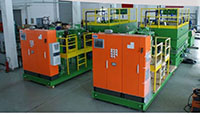Coolant Filtration Systems
Featured Products
Soluable Oil Filter Experience
- Successfully installed 32 Coolant Filter Systems since 2009 for 16 different customers
- Multiple systems on each continent
- Retrofitted existing paper and press systems to Cuno cartridge filters
- Expanded existing systems to support additional can lines
- Start up and Commissioning typically takes 3-4 days
- Spare parts available through Roeslein (instead of contacting multiple suppliers)
- Roeslein's approach to customer support is well known throughout the industry
- Mechanical and electrical engineers are available after Start up and Commissioning to answer any questions customers may have
- Maintain good relationships with Henkel and Quaker coolant supply companies when troubleshooting unique operational issues
- Standard 3M Cuno cartridge filter housings handle up to 520 gpm [1968 Ipm]
- Larger 3M Cuno cartridge filter housings handle up to 850 gpm [3,217 Ipm]
- First set of 3M Micro-Klean III resin bonded filter cartridges supplied
Unit of Measure
| Items |
 /Asset/a1005.jpg /Asset/a1005.jpg CFS-01 Coolant Filtration System with Unfiltered Tank List Price QUOTE
|
 /Asset/a1005.jpg /Asset/a1005.jpg CFS-02 Coolant Filtration System with Tank List Price QUOTE
|
||
| Tank Capacity | N/A 4840 gal18321 L | N/A 860 gal3255 L | ||
| Filter Type | N/A 3M Cuno cartridge filter housing 3M Micro-Klean III resin bonded filter cartridges | |||
| Flow Rates | N/A up to 520 gpmup to 1968 L/min | |||
| Standard System Features |
N/A
|
|||
| Controls Overview |
N/A
User control ability<ul><li><li>Enable and Stop the system</li>Reset Drive/Motor faults</li><li>Review the overall system status</li><ul><li>Tank levels & temperature</li><li>Drive/Motor status</li><li>Control Valve & Solenoid status</li></ul><li>Filter s |
|||
| Controls - Filters |
N/A
User ability<ul><li>Review the differential pressure of the filter in use</li><li>Reset the status of the filter after cartridge change</li></ul>Other Features<ul><li>Active Alarm screen</li><li>Alarm History screen with password protected clearing of ala |
|||
| Panel Design |
N/A
<ul><li>Allen-Bradley HMI and Drives</li><li>Single NEMA4/12 Control Panel with air conditioner mounted on main skid</li><li>Variable Speed Drives for all main pumps</li><li>Local Sump Tank control station with pump motor Drives</li><li>Ethernet communica |
|||
| Tramp Oil Control / Removal Options |
N/A
|
|||
|
|
||||
 Global
Global +1 314 729 0055
+1 314 729 0055 parts@roeslein.com
parts@roeslein.com
